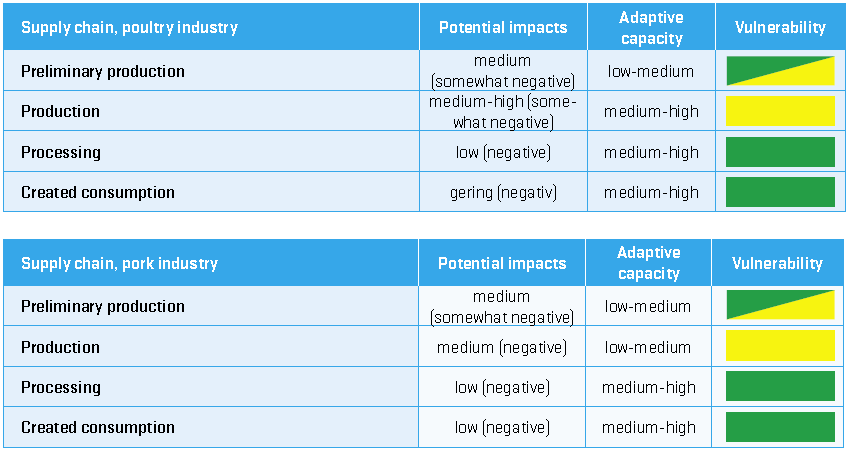CluE - Cluster Ernährungswissenschaft
Vulnerability Analysis
Vulnerability means susceptibility to injury. So-called vulnerability analysis investigates the extent to which certain sectors, such as the fish sector, will be affected by climate change. In other words, an examination is carried out to determine where the essential weak points are, in terms of the transformation caused by climate change. Once we have ascertained where the greatest vulnerability is located, we will also be able to determine where more concerted action will be required in the future.
In the context of CluE, a certain methodology, the so-called value-added-chain-referenced vulnerability analysis method (cf. Akamp et al., 2010), is used to examine the following sectors of the food industry:
- the porc sector
- the poultry sector
- the dairy sector, and
- the fish sector.
For each of these sectors, empirical surveys, some of them very extensive, have been carried out, including discussions with experts and a review of the literature and of international studies, the final result being a statement on the respective degree of vulnerability. The following tables provide an overview of the results of the vulnerability analysis:
THE PORK- AND POULTRY SECTORS

Source: short & sharp no. 4: Vulnerability Analysis Food Industry.
The front end of the value-added chain, particularly feed farming and production, is more strongly affected by climate change, while these effects decrease as one moves down the chain toward trade and consumption. While the greater vulnerability at the front-end sections of the chain is manageable, thanks to sophisticated technological control mechanisms, it has become apparent how complex the effects of climate change will nonetheless be for the meat sector. Adaptation mechanisms also depend on the structure of the value-added chain. With a loose value-added chain structure, such as in the pork sector, individual and variegated adaptation strategies could be applied, while in the poultry sector, where a large part of the activities are carried out under the roof of a single integrated operation, concrete adaptation decisions would have to be provided by an industry-wide consensus, or else the integrator would have to be convinced; however, the measures could be more rapidly implemented.
Contact for the meat sector:
Marion Akamp (marion.akamp uni-oldenburg.de)
uni-oldenburg.de)
Hedda Schattke (hedda.schattke uni-oldenburg.de)
uni-oldenburg.de)
THE DAIRY SECTOR

Source: short & sharp no. 4: Vulnerability Analysis Food Industry.
Contact for the dairy sector
Dr. Michael Mesterharm (michael.mesterharm uni-oldenburg.de)
uni-oldenburg.de)
THE FISH SECTOR

Source: short & sharp no. 4: Vulnerability Analysis Food Industry.
Clearly, fisheries, as the preliminary stage of the value-added chain of the fish sector, will be affected by the transformation caused by climate change. Subsequent stages of the chain will have a greater degree of leeway, but they too are of course to a certain degree dependent on the preliminary stage, and cannot depend on the production of aquaculture as a substitute to an unlimited degree.
Contact for the fisheries sector:
Marina Beermann (marina.beermann uni-oldenburg.de)
uni-oldenburg.de)
Short & Sharp No. 4: Vulnerability Analysis of the Food Industry
